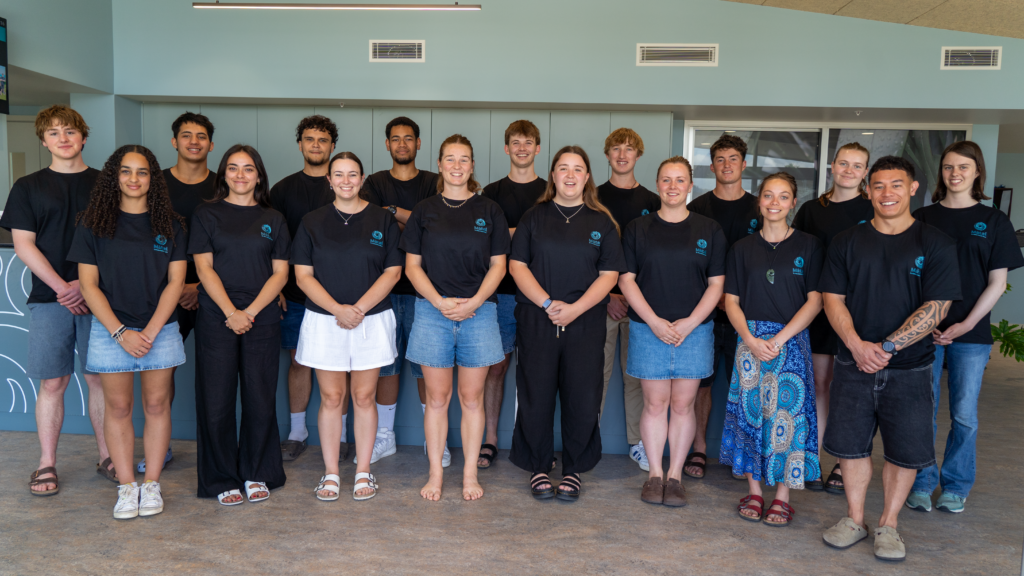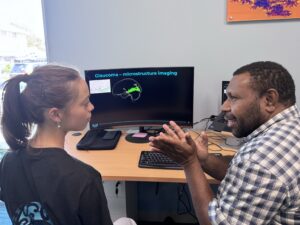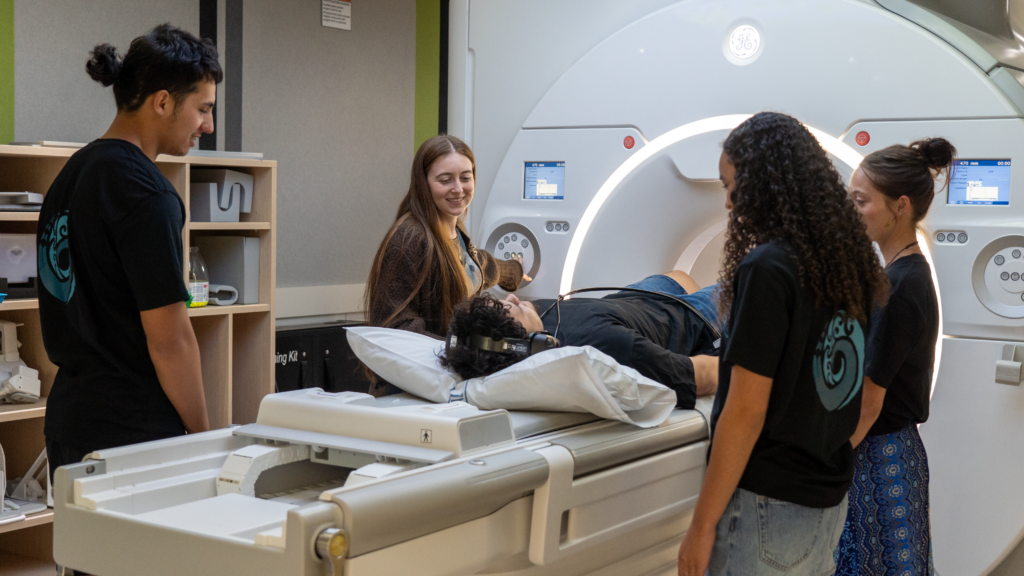In the summer of 2024/25, Mātai was able to offer local summer internships to 16 students.
June 2025
From cutting-edge medical imaging to bioengineering, leadership, innovative research, and mātauranga Māori, our Mātai Summer Internship Programme gave 16 outstanding interns the chance to tackle real-world health challenges.
The interns explored a range of topics, including research methods, scientific training, leadership, and mātauranga Māori. Interns were guided by 23 supervisors and speakers across academia, healthcare, community, and industry – interns worked in a number of areas including brain research, AI-driven diagnostics, and community-centred healthcare solutions.
This year, Mātai was proud to have ANZ Aotearoa as a major supporter of the programme, reinforcing their commitment to strengthening community resilience. Other major supporters include Hugh Green Foundation (cornerstone funder), Trust Tairāwhiti, Turanga Health, and Pultron Composites Ltd.
Mātai CE & research director Dr Samantha Holdsworth said the intern programme was an important part of Mātai, allowing students engaged in tertiary education to carry-out research with the support and input of the Mātai team and collaborators.
Many students left the programme feeling inspired to return home in the future, eager to give back to their community.
Here is a glimpse of the students, and the projects they worked on in this year’s programme.

Back row (from left): Harry Naske, Brayden Maxwell, Tupuhi Gardner, Tevita ‘Akau’ola, Luke Stoltenberg, Samuel Porter, Nic Proffit, Keeley Cairns, Holly Flyger Front row (from left): Ella Arthur, Hayley Templer, Rachael McLanachan, Holly Williams, Anna Heikell, Imogen Amor Bendall, Alani McLeod, Braden Fowell (Junior Project Coordinator).
 Luke Stoltenberg
Luke Stoltenberg
University of Canterbury Electrical and Electronic Engineering , (2nd Year)
Former Gisborne Boys’ High School Head Prefect
Luke explored the effects of noise (caused by low signal strength or interference, which can make images blurry or unclear – similar to static on a radio) on a cutting-edge MRI technique called Quantitative Amplified MRI (q-aMRI). The method, developed by Mātai and collaborators, is used to detect subtle brain motion. Luke’s goal was to assess how well it performs under noisy conditions, to ensure reliability when applied on brain images.
 Alani McLeod
Alani McLeod
University of Canterbury, Bachelor of Mechanical Engineering (HONS) (2nd Year)
Former Gisborne Girls’ High School Head Prefect
Alani’s project aims to develop a non-invasive method to detect glaucoma. This is done by using advanced diffusion MRI technique to study specific brain fibre tract (brain wiring) in the visual pathway and find potential biomarkers. Alani is pictured to the right with her project supervisor, Dr Loxlan Kasa, Mātai Research Fellow.
To have the priviledge of being an intern has been amazing. Mātai has provided so much exposure about the workforce and unveiled a world of possibilities. I’ve been inspired by the strong sense of community and appreciation/integration of mātauranga Māori. This internship has increased my interest in pursuing a minor in biomedical engineering next year. I will carry forward the value of meaningful community engagement and strong relationships that I’ve observed here into my future workplaces. I’ve gained practical skills and knowledge around coding and using segmentation software as well as developing my leadership and interpersonal skills. I hope to use my engineering skills in a job that contributes to making meaningful impacts.
Anna Heikell
University of Otago, Physiotherapy (2nd Year)
Campion College
Anna conducted a literature review on the interface of MRI and physiotherapy in New Zealand, identifying barriers and future opportunities for integrating MRI in physiotherapy practice.
Nic Proffit
University of Otago, Dentistry (5th Year)
Gisborne Boys’ High School
Nic’s project was on “Pushing the Limits of Bone Imaging: UTE Acquisition and 3D printing of Teeth and Skull”. He explored various MRI techniques for dental imaging. The aim was to explore the novel application of MRI in dental imaging.
Harry Naske
University of Canterbury, Engineering (Hons)
Gisborne Boys’ High School
Harry’s research examined how methamphetamine use affects brain movement and if these movements return to normal after prolonged abstinence using advanced brain imaging techniques. While, uncovering potential recovery patterns through brain imaging. This research could shed new light on the effect of meth use on the brain, and help better understanding of brain recovery.
Ella Arthur
University of Otago, Dentistry (2nd Year)
Campion College
Ella’s study aimed to analyse heart MRI scans from individuals with methamphetamine addiction and healthy controls to assess differences in cardiac health between these groups. The objective was to identify trends, and provide insights into the long-term effects of methamphetamine addiction on heart health and investigate the signs of recovery in individuals in their abstinence journey.
Ella Arthur
University of Otago, Dentistry (2nd Year)
Campion College
Ella’s study aimed to analyse heart MRI scans from individuals with methamphetamine addiction and healthy controls to assess differences in cardiac health between these groups. The objective was to identify trends, and provide insights into the long-term effects of methamphetamine addiction on heart health and investigate the signs of recovery in individuals in their abstinence journey.
Brayden Maxwell
University of Auckland, Biomedical Science (2nd Year)
Gisborne Boys’ High School
Brain-RePAIR focused on brain recovery in adolescents using imaging after a rugby season. The goal of this study is to explore brain recovery processes to inform improved stand-down periods and return to play protocols.
Brayden’s second project involved analysing user responses to VR based ‘Brainwatch’, which involved analysing responses from local adolescent students who used a VR brain interface. The analysis compared pre- and post-interaction responses to create clear, visually engaging data plots, illustrating the effectiveness of VR as an educational tool.
Tevita ‘Akau’ola
University of Auckland, Software Engineering (2nd Year)
Gisborne Boys’ High School
In long-term MRI studies, a common challenge is the inconsistency of measurements across scans. This project aims to determine the extent of variability in various MRI sequences that can still be considered normal. It involves learning the process of recruiting participants for scans and developing code to extract and analyse brain measurements.
Samuel Porter
University of Canterbury, Mechanical Engineering (2nd Year)
Samuel’s research focused on developing a deep-learning algorithm to automate white matter segmentation in Ultra-High Contrast MRI, enhancing brain disorder assessments. The aim was to achieve highly accurate segmentation, to enhance the potential of the new imaging technique, ultimately, to enable better review of brain disorders.
Imogen Amor Bendall
University of Otago, Neuroscience (3rd Year)
Campion College
Many people with a Traumatic Brain Injury (TBI) carry on experiencing ongoing effects of their injury, which we believe can often be discredited. This project aims to create a hierarchy of symptoms after TBI, to improve the understanding of the presentation of TBI symptoms and open areas for further research.
Hayley Templer
Victoria University of Wellington, Psychology (2nd Year)
Gisborne Girls’ High School
Hayley worked on the Tairāwhiti Child Well-being study. This project focuses on creating a normative database that can be applied to a diverse range of children using advanced MRI, through a community-led culturally grounded and inclusive approach.
During Hayley’s time on the Tairāwhiti Child Well-being study, she produced a range different materials for tamariki to engage with, to learn about MRI, and become more comfortable with the machine. She also helped by upholding the projects focus to create a normative database that can be applied to a diverse range of tamariki using advanced MRI, through a community-led culturally grounded and inclusive approach.
Rachael McLanachan
University of Otago, Anatomy (4th Year)
Gisborne Girls’ High School
Rachael analysed volume differences in the substantia nigra (a part of the brain that helps control movement by producing dopamine) in methamphetamine users to determine differences that could contribute to our understanding of addiction-related brain changes.
Holly Williams
University of Canterbury, Psychology (5th Year)
Gisborne Girls’ High School, St Peter’s Cambridge
This project, led by Professor Holly Thorpe, aims to capture the voices of Rangatahi from flood-affected Tairāwhiti Gisborne. It explores how local youth have been impacted by recent extreme weather events, the effects on their families and community, and their hopes and concerns for the future.
Tupuhi Gardner
University of Auckland, Computer Science (3rd Year)
TKKM o Ngā Uri a Maui, Gisborne Boys’ High School
Tupuhi worked on a project led by Rongowhakaata Iwi Trust CEO Teina Moetara to investigate the connection between vitality and the functionality of brain networks, using MRI scans. Vitality in this study refers to a person’s connection to their personal identity as tangata whenua (traditional custodians of the land) as well as connection to place. Tupuhi also played a pivotal role in mātauranga Māori at Mātai, by leading a mihi whakatau, hosting visitors, and being a role model for all.
Keeley Cairns
Victoria University of Wellington, Biomedical Science (2nd Year)
Gisborne Girls’ High School
Keeley conducting a systematic review to investigate the genetics of traumatic brain injury (TBI) recovery and comparing it to genetic predispositions for brain disease. This involves identifying relevant genes and variants associated with recovery outcomes after TBI and understanding how baseline genetic factors contribute to recovery variability. This could help unlock new insights into brain health.
Holly Flyger
University of Auckland, Biomedical Engineering (3rd Year)
Gisborne Girls’ High School
Holly Flyger, a Mātai Sc holarship recipient, returns for her second internship after an impressive first year. At just 19 years old, the former Gisborne Girls’ High School student had a paper she worked on published in the prestigious Journal of Neural Regeneration Research. This is an extraordinary accomplishment, as many researchers spend years in their academic careers before reaching this stage, making Holly’s success even more notable.
holarship recipient, returns for her second internship after an impressive first year. At just 19 years old, the former Gisborne Girls’ High School student had a paper she worked on published in the prestigious Journal of Neural Regeneration Research. This is an extraordinary accomplishment, as many researchers spend years in their academic careers before reaching this stage, making Holly’s success even more notable.
This year, Holly’s research focused on how a person’s movement in the MRI scanner affects videos acquired through advanced MRI techniques, including aMRI and q-aMRI.
The multi-session part of the programme featured dynamic leadership training with Stu Potter, where participants gained game-changing insights into professional development, sharpened their communication skills, and learned to navigate their future careers with confidence. Dr Josh McGeown provided valuable training in research design, ethics, and mentoring, while Kiwi MRI pioneer Emeritus Professor Terry Peters taught the physics and mathematics of MRI and Dr Mark Griffin led a comprehensive course on statistics and data visualisation. Neuropsychiatrist Dr Gil Newburn guided participants through the fundamental principles of brain function and their influence on behaviour and thought patterns. Simeon and Maurice Alford from Aroha AI offered insights into the rapidly evolving world of artificial intelligence, highlighting its impact on research and healthcare.
Standout sessions were waiata with Kahui Pakeke at Te Whatu Ora Tairāwhiti, which deepened participants’ connection to mātauranga Māori.
Mātai would like to acknowledge Te Puni Kōkiri cadetships, a major previous supporter and EIT Tairawhiti for providing space for our interns, and the Mangatawa Beale Williams Memorial Trust for their support toward Mātai, which provided the space where our interns worked. We thank the JN & HB Williams Foundation for supporting the space where STEM educator Tōnui Collab sits, strengthening our education pipeline, and the Quest Enterprise Trust for contributing to the space where our research fellows mentored and supported the interns.
A special thanks to the NZ Health Research Council and the Royal Society Te Apārangi Marsden Fund for providing research funding that enabled some of our interns to pursue their projects, and to the New Zealand eScience Infrastructure for their support in high-performance computing.
Supervisors included representation from Mātai, University of Auckland, University of Waikato, University of Otago, StardustMe, Rongowhakaata, Aroha AI Limited, Te Rito Maioha, UrbanismPlus, Taike-E!, Te Rito Maioha, Insight Business Management, Robarts Research Institute Canada, HintHealth, Microsoft, Te Whatu Ora Tairāwhiti, and more.
To all our supporters and funders, we are incredibly grateful for making this programme possible.